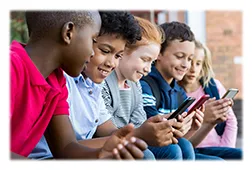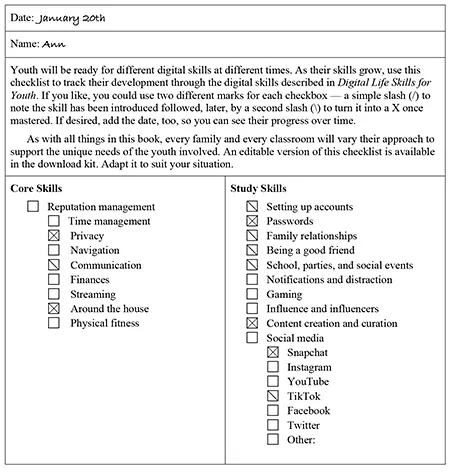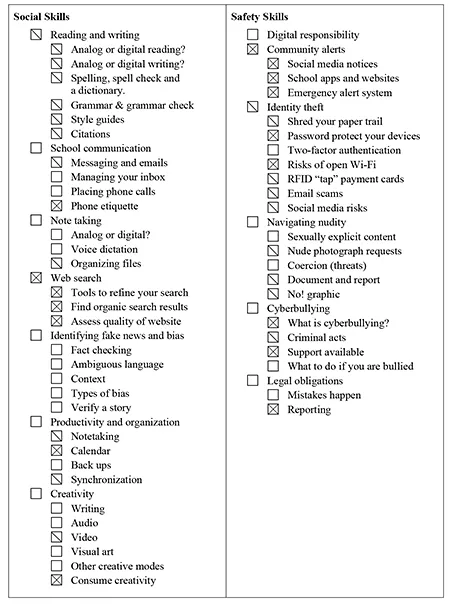![]()
Chapter 1
Digital Citizenship
If we think of the internet as a place, not a thing, we can extend the metaphor and think of the internet as a worldwide community in a virtual place. While that place has no street address, it is a place where people can gather no matter where they are in the world. A friend in Adelaide is just as reachable as a friend in Chicago, keeping in mind the time zones, of course. It’s a place where we gather in a technology-rich, digitally driven environment that comes with opportunities and responsibilities.
Anyone who goes online participates in this global community and, by extension, becomes a citizen of the internet. As a digital citizen, you participate online within a set of ground rules or acceptable behaviors. What’s OK in one part of the internet will not be OK in another part so it’s important to learn how to connect with people and information under different virtual conditions. These customs of digital citizenship evolve over time to reflect people’s experiences and the technology’s ever-expanding capabilities.
At its simplest, a digital citizen is someone who uses information technology as they go about their daily activities.
Many people write about digital citizenship. In fact, my son’s class recently had to write an essay on the topic and dozens of Grade 8 students had to contemplate what this means to them. Sean Crocker, age 12, wrote, “You become a digital citizen by choice, not genetically. Being a good digital citizen means that, among other things, you know responsibilities from irresponsibilities.”
The Office of the eSafety Commissioner in Australia promotes a three-pronged definition: engage, know, and choose. Their work contends that anyone who visits the internet is a digital citizen and recommends that digital citizens “Engage positively. Know your online world. Choose consciously.”
Mike Ribble, Director of Technology for the Manhattan-Ogden Public Schools in Kansas, offers a parallel view. He defines digital citizenship: “Digital citizenship is the continuously developing norms of appropriate, responsible, and empowered technology use.” (www.digitalcitizenship.net, accessed May, 2019). Mr. Ribble’s work on digital citizenship provides a detailed framework of nine elements with an overlay of three overriding principles: Be safe. Be savvy. Be social. The nine elements deeply explore the complex array of skills and knowledge needed to function fully as a digital citizen. These include access; commerce; communication and collaboration; rights and responsibilities; health and wellness; fluency; security and privacy; etiquette; and law. These overlapping and intersecting elements collectively provide a rich and complex definition of digital citizenship. You can read more about them at www.digitalcitizenship.net/nine-elements.html.
Teachers, I encourage you to explore the information and resources available from Mike Ribble. His website includes a functional and helpful digital citizenship progression chart that enumerates the nine elements by grouped grade level including notes on the cross-curriculum connections. www.digitalcitizenship.net/dc-progression-chart.html
However you describe digital citizenship, youth need to learn the rules, customs, and responsibilities over time. And, along the way, they’re going to make mistakes and learn from those mistakes. And, yes, they may make the same mistake over and over before they learn. That’s part of growing up. But, if we provide them with guidance we can help them be safe online while they enjoy their place in the global online community.
This book explores a variety of skills that youth need to learn as they grow into their role as digital citizens. The skills are broadly grouped in four categories — core skills, social skills, study skills, and safety skills. While written in a particular order in the book, parents and teachers should introduce and mentor skills as needed by the youth around them. To help you keep track of your efforts, Sample 3 shows you the Digital Life Skills Master Checklist also available on the download kit. Make a copy of this list to note skills your youth knows and the ones you want to support them in next. You’ll revisit this checklist in Chapter 6.
Sample 3: Digital Life Skills Master Checklist
1. Acceptable Behavior
When and where to use technology is a hot topic. Every family and every school have different rules for what works for them. Some feel that anytime is a good time while others feel that it should be heavily regulated with strict time blocks for access to technology and the internet. As youth figure out digital life skills, they learn when and where they are allowed to get connected and they figure out strategies to circumvent the rules they’ve been asked to follow.
In my opinion, neither the free-for-all nor the heavily restricted models are effective with youth. Given access to technology without restrictions, they have fewer opportunities to learn acceptable behavior. Overly restricted youth suffer the same difficulty. That said, the degree to which youth can self-control their screen time and web surfing varies depending on their age, maturity, and circumstances.
So how do parents and teachers proceed? At home, parents set the rules. At school, teachers are in charge. Youth need some parameters to help them figure what they are allowed to do and when. At the same time, society as a whole needs to acknowledge that all digital actions look much the same; head down, thumbs on mobile phone screen. What’s less clear at a distance is what a person is doing when they are taking digital action.
Take for example, Gijsbert van der Wal’s viral photograph of students on their mobile phones in front of Rembrandt’s The Night Watch (www.telegraph.co.uk/news/newstopics/howaboutthat/12103150/Rembrandt-The-Night-Watch-The-real-story-behind-the-kids-on-phones-photo.html, accessed May, 2019). When this photo first circulated, the response was a universal outcry that youth were ignoring the masterpiece next to them. However, that response took the moment out of context, as the students had been examining the painting and turned to their mobile phones to do a complementary learning activity on the museum’s app.
Similarly, people will often decry that people are always on their mobile phones while commuting by train or bus and not talking to one another. However, Gary Vaynerchuk countered that assumption of acceptable behavior, with a 1947 photo of commuters reading their newspapers on a subway car. He noted, “every single person, even though they’re in a confined space together, aren’t paying any attention to each other because they’re reading media on a newspaper. The recent version of this is, of course, cellphones and iPads, yet the same people out there who hate change continue to cry foul.” (Medium, “Technology Hasn’t Changed Us,” accessed December 28, 2013.)
Another battleground is the family dinner table. As with all digital behaviors, there are a range of acceptable options. For some, the dinner table is an opportunity to come together and talk about the day. Others, perhaps more introverted, enjoy the companionable silence of eating alone-together without devices. Yet, other families gather to eat and consume media on their phones at the same time. We can’t assume that this family doesn’t communicate at other times of day; this is simply the behavior they deem acceptable at the dinner table. My family has variable rules. When at home, we don’t allow devices at the table and enjoy our chance to talk to one another. In restaurants, devices stay put away until we’ve ordered our food and then go away again when the food arrives. For us, the noise of a restaurant is an impediment to conversation. And we have a third variation when we travel, especially for road trips, where devices are allowed at meals. This is often our only access to internet and we want to connect with media and people during our travels. And we have lots and lots of time to talk in the car when we’re back on the road again. As with all things, acceptable behavior varies for meal times and other times.
The digital life lesson is to help youth understand the variations in the rules and ways to learn what behavior is OK in a given situation. Schools will often post device-use policies that are reinforced by teachers, including authorized exceptions, in class regularly. In social situations, youth learn to take their cue from observing what others are doing. If all the adults have their phones out, then the youth may feel they can do the same. If that’s not a clear signal, youth can learn to ask what’s permitted. Or, choose to follow their own standards of behavior, as needed.
It’s also important to remember that youth don’t remember a world without mobile phones and the internet. To them, this is how its always been and they don’t have any memories to wax nostalgic about a time when there were only 13 television channels and people couldn’t be reached 24/7. Their life experience informs their behavior. Even for adults, our behavior is also shifting as we live increasingly digital lives. Author and artist Douglas Coupland cleverly reminds us that ‘I no longer remember my pre-internet brain.” (“Douglas Coupland: ’I no longer remember my pre-internet brain’,” CNN Style, January 19, 2018). If adults are struggling to remember, how can we ask youth to live by standards that they have no memory of?
Of course, the impacts of digital living are an ongoing experiment, just as every type of media — books, radio, television — has been before. “[When] it comes to spending a childhood in front of a screen, this generation are like lab rats. The long-term impact is not known,” notes psychologist Sue Palmer. (“Why the iPad is a far bigger threat to our children than anyone realizes: Ten years ago, psychologist Sue Palmer predicted the toxic effects of social media. Now she sees a worrying new danger … ” Daily Mail, January 27, 2016). This is, in part, why youth need guidance to understand not only what’s acceptable behavior but, also, to learn the positive and negative impacts of digital activities.
To do this, parents and teachers must be present whenever feasible. Some will choose to watchdog every online action while others will not pay any attention at all. As usual, I advocate for a middle ground where youth are getting some opportunities to be online unsupervised and to practice acceptable behaviors with technology while also spending some time in discussion with parents and teachers. The amount of supervision a youth needs varies by age, maturity, and other milestones. Parents will know and advocate for what’s best for their children while teachers will enforce a standard that suits each class community as a whole.
As parents and teachers observe youth’s behavior online, I encourage them to praise the good behavior and to call out poor behavior. Grade 7 teacher Ryan Hong, an active education technology innovator, kindly but firmly rebukes inappropriate student comments on his classroom Instagram account (@MrHongsClass). In one instance he wrote, “You need to secure your account and adjust your language. Thank you for your cooperation! Digital citizenship is important! This is your digital footprint that will remain with you.” Calling out bad behavior and offering specific guidance for how to shift to acceptable behavior is a constructive way to proceed. In brief, be kind but firm.
In addition, I encourage you to be transparent about your own digital behavior. Even parents and teachers make mistakes. The key is you have to acknowledge the error and note the teachable moment. Just as you learn from your mistakes, you share the lesson and model for our kids that they can recover from a mistake. Redacted. Apology. Thank you.
2. Access to Technology
One of the biggest challenges for parents is deciding when (not if just when) a child or teenager will have access to technology such as a laptop, tablet, or mobile phone. And there’s no one-size-fits-all answer to this question.
Famously, industry leaders from the computer and technology industry are reported to prevent their kids from having access to computers and mobile phones. Household names like Melinda and Bill Gates, Steve Jobs, Mark Zuckerberg, and others are said to ban or restrict their children’s use of technology and internet access. The implication in this oft reported news is that these technology insiders know something that average parents do not. While you may want to follow suit and shelter your kids from technology and the internet, I don’t see it as a practical solution. Youth are going to need access to technology to complete school assignments, manage their own banking, communicate with friends, and more. Even if a family decides to limit streaming entertainment, social media, and gaming, youth will still need to access devices to learn on. That said, they don’t necessarily need a personal device to use all the time. A family computer or a shared tablet might be sufficient, at least to start.
Economics is a key driving factor when it comes to access to technology. For some families, it’s a financial restriction. Technology is expensive and with each device costing $500 to $1,000, or more, the expenses add up quickly. Add to that monthly costs for a mobile phone plan that may also include data charges. And if your household has more than one youth, it’s a juggle to figure out who will get a device and when. Of course, youth may earn their own money and buy computers, mobile phones, and accessories.
Schools too struggle with the expenses associated with technology. Classroom sets of iPads, computer labs, and laptop stations are a huge hardware investment. On top of that, enterprise level software licenses are required and there has to be dedicated staff available to update, troubleshoot, and otherwise maintain each device.
As schools struggle with these costs, many districts ...




